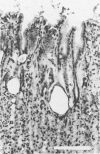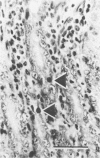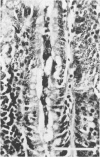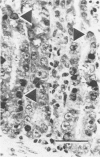Abstract
Mink virus enteritis, feline panleukopenia and canine parvovirus-2 were inoculated separately into groups of raccoon, mink, red fox and striped skunk. Raccoons were highly susceptible to mink virus enteritis and feline panleukopenia, with animals developing clinical illness, and several dying within six to ten days of inoculation with lesions typical of parvovirus infection. Both viruses were shed in high titre in the feces of infected raccoons, and high antibody titres were stimulated. Raccoons inoculated with canine parvovirus-2 showed no signs; shedding of virus was sporadic though moderate titres of antibody developed. Mink inoculated with mink virus enteritis and feline panleukopenia developed signs and lesions of early parvovirus infection. No signs or significant lesions followed canine parvovirus-2 inoculation. Shedding of virus was heavy (mink virus enteritis) or sporadic (feline panleukopenia and canine parvovirus-2), though good serological responses were elicited to all three viruses. Red fox showed no signs of infection, shed all three viruses only sporadically, and the serological response was strong only to feline panleukopenia. Skunks developed low antibody titres, but no signs, and did not shed virus. Antibody to parvovirus was found in 79.2% of 144 wild red foxes; 22.3% of 112 wild raccoons; 1.3% of 157 wild skunks and 6/7 coyotes in southern Ontario. The likely significance of these viruses to wild and captive individuals and populations of these carnivores is discussed.
Full text
PDF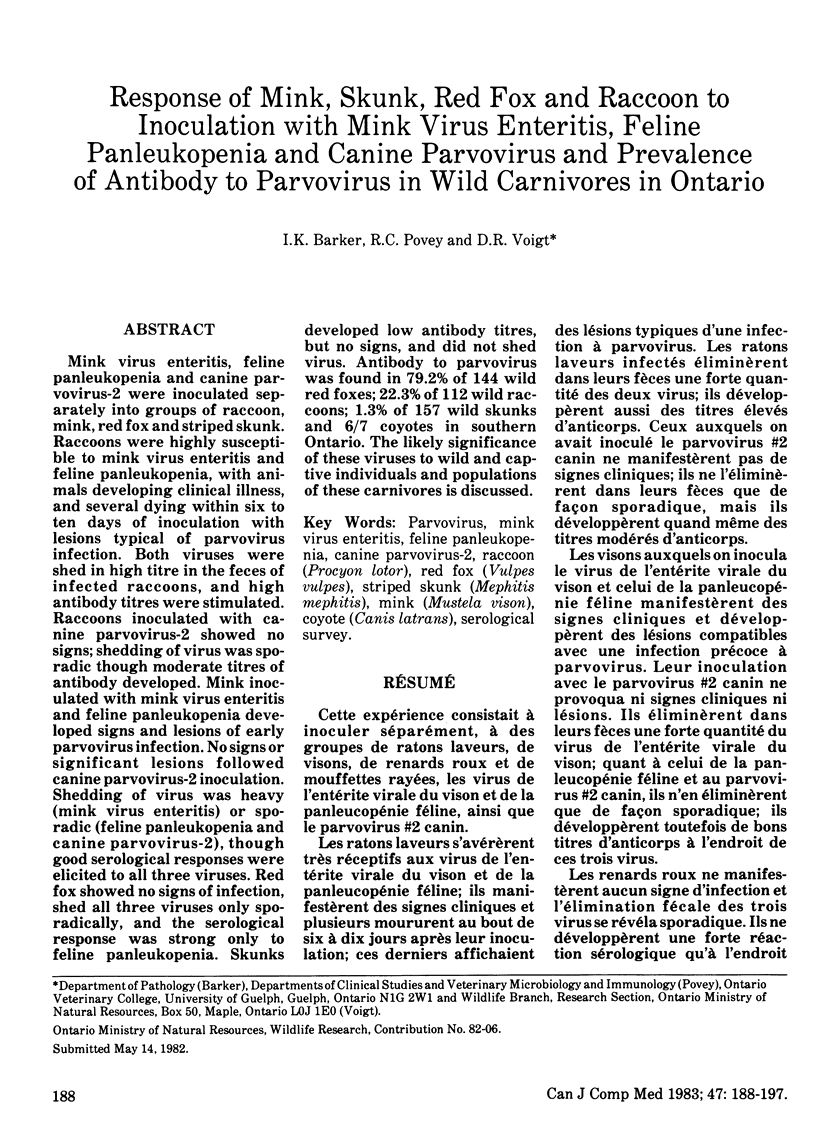


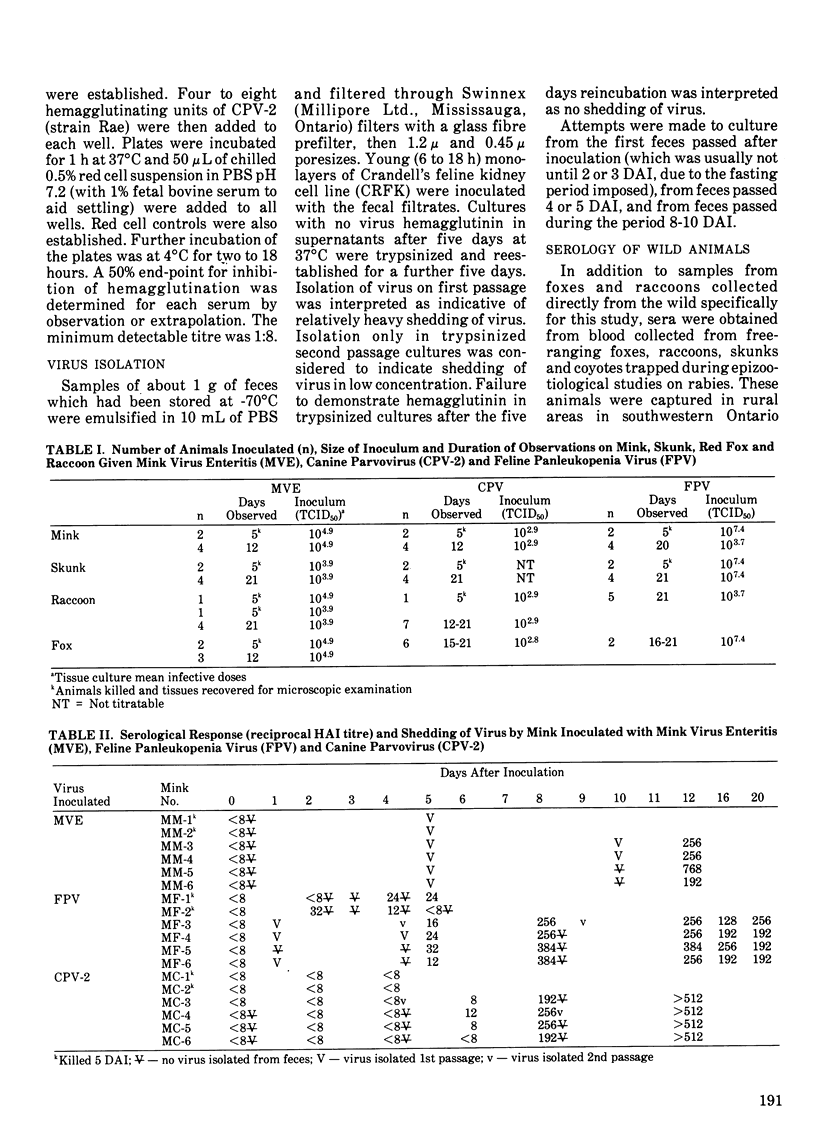
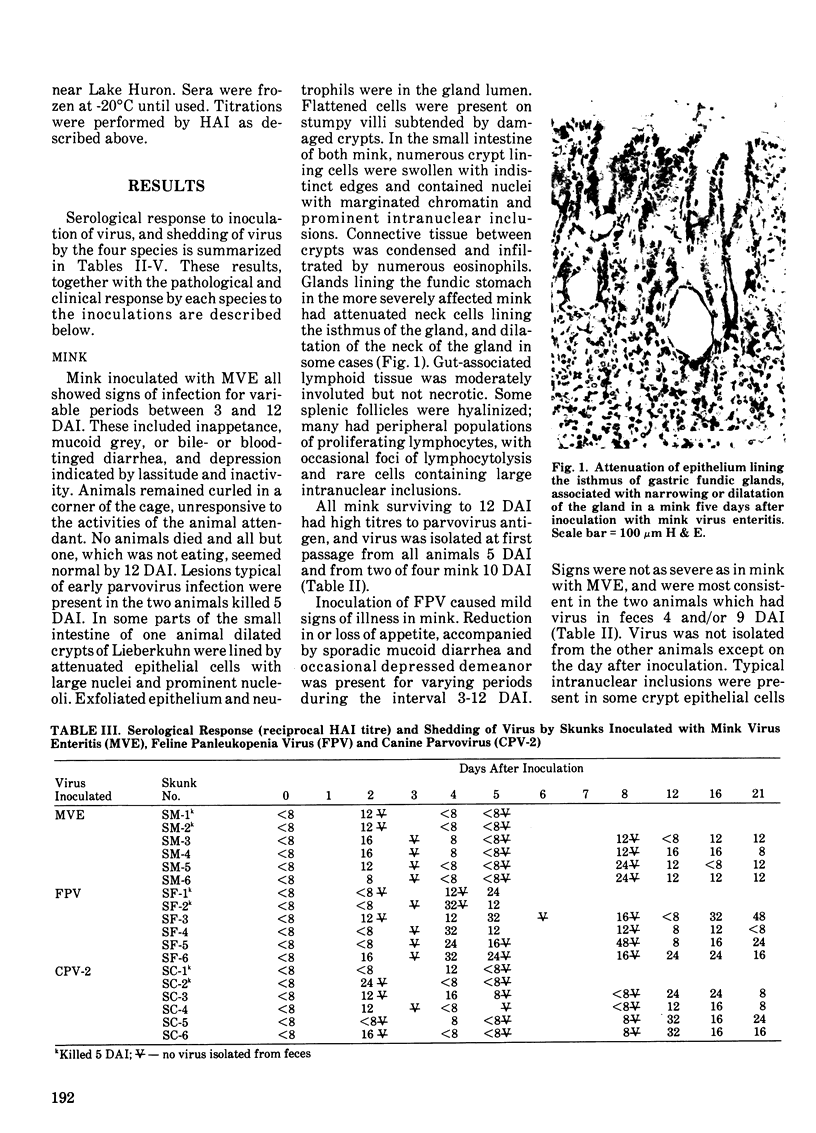


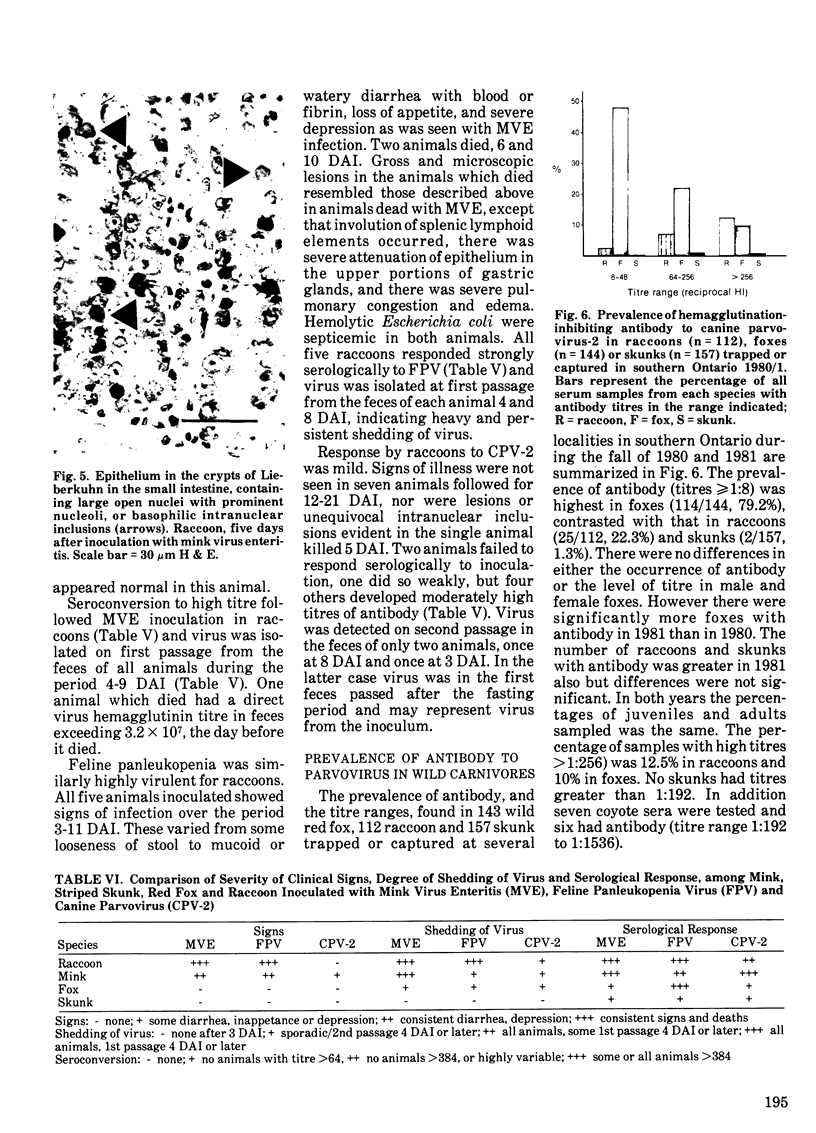

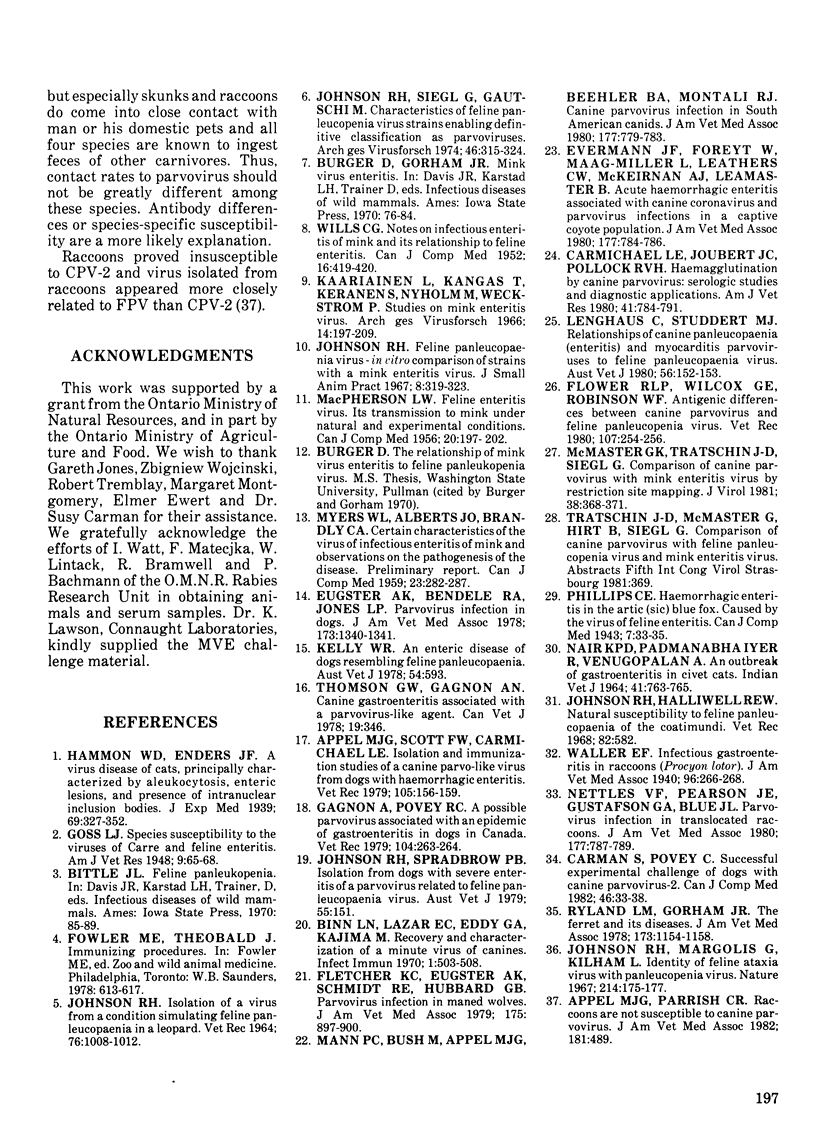
Images in this article
Selected References
These references are in PubMed. This may not be the complete list of references from this article.
- Appel M. J., Parrish C. R. Raccoons are not susceptible to canine parvovirus. J Am Vet Med Assoc. 1982 Sep 1;181(5):489–489. [PubMed] [Google Scholar]
- Appel M. J., Scott F. W., Carmichael L. E. Isolation and immunisation studies of a canine parco-like virus from dogs with haemorrhagic enteritis. Vet Rec. 1979 Aug 25;105(8):156–159. doi: 10.1136/vr.105.8.156. [DOI] [PubMed] [Google Scholar]
- Binn L. N., Lazar E. C., Eddy G. A., Kajima M. Recovery and characterization of a minute virus of canines. Infect Immun. 1970 May;1(5):503–508. doi: 10.1128/iai.1.5.503-508.1970. [DOI] [PMC free article] [PubMed] [Google Scholar]
- Carman S., Povey C. Successful experimental challenge of dogs with canine parvovirus-2. Can J Comp Med. 1982 Jan;46(1):33–38. [PMC free article] [PubMed] [Google Scholar]
- Carmichael L. E., Joubert J. C., Pollock R. V. Hemagglutination by canine parvovirus: serologic studies and diagnostic applications. Am J Vet Res. 1980 May;41(5):784–791. [PubMed] [Google Scholar]
- Eugster A. K., Bendele R. A., Jones L. P. Parvovirus infection in dogs. J Am Vet Med Assoc. 1978 Nov 15;173(10):1340–1341. [PubMed] [Google Scholar]
- Evermann J. F., Foreyt W., Maag-Miller L., Leathers C. W., McKeirnan A. J., LeaMaster B. Acute hemorrhagic enteritis associated with canine coronavirus and parvovirus infections in a captive coyote population. J Am Vet Med Assoc. 1980 Nov 1;177(9):784–786. [PubMed] [Google Scholar]
- Fletcher K. C., Eugster A. K., Schmidt R. E., Hubbard G. B. Parvovirus infection in maned wolves. J Am Vet Med Assoc. 1979 Nov 1;175(9):897–900. [PubMed] [Google Scholar]
- Flower R. L., Wilcox G. E., Robinson W. F. Antigenic differences between canine parvovirus and feline panleucopenia virus. Vet Rec. 1980 Sep 13;107(11):254–256. doi: 10.1136/vr.107.11.254-a. [DOI] [PubMed] [Google Scholar]
- Gagnon A. N., Povey R. C. A possible parvovirus associated with an epidemic gastroenteritis of dogs in Canada. Vet Rec. 1979 Mar 24;104(12):263–264. doi: 10.1136/vr.104.12.263. [DOI] [PubMed] [Google Scholar]
- Johnson R. H. Feline panleucopaenia virus--in vitro comparison og strains with a mink enteritis virus. J Small Anim Pract. 1967 Jun;8(6):319–324. doi: 10.1111/j.1748-5827.1967.tb04557.x. [DOI] [PubMed] [Google Scholar]
- Johnson R. H., Margolis G., Kilham L. Identity of feline ataxia virus with feline panleucopenia virus. Nature. 1967 Apr 8;214(5084):175–177. doi: 10.1038/214175a0. [DOI] [PubMed] [Google Scholar]
- Johnson R. H., Siegl G., Gautschi M. Characteristics of feline panleucopaenia virus strains enabling definitive classification as parvoviruses. Arch Gesamte Virusforsch. 1974;46(3-4):315–324. doi: 10.1007/BF01240073. [DOI] [PubMed] [Google Scholar]
- Kelly W. R. An enteric disease of dogs reselmbing feline panleucopaenia. Aust Vet J. 1978 Dec;54(12):593–593. doi: 10.1111/j.1751-0813.1978.tb02426.x. [DOI] [PubMed] [Google Scholar]
- Käriäinen L., Kangas J., Keränen S., Nyholm M., Weckström P. Studies on mink enteritis virus. Arch Gesamte Virusforsch. 1966;19(2):197–209. doi: 10.1007/BF01241499. [DOI] [PubMed] [Google Scholar]
- Lenghaus C., Studdert M. J. Relationships of canine panleucopaenia (enteritis) and myocarditis paroviruses to feline panleucopaenia virus. Aust Vet J. 1980 Mar;56(3):152–153. doi: 10.1111/j.1751-0813.1980.tb05663.x. [DOI] [PubMed] [Google Scholar]
- Macpherson L. W. Feline Enteritis Virus - Its Transmission To Mink Under Natural And Experimental Conditions. Can J Comp Med Vet Sci. 1956 Jun;20(6):197–202. [PMC free article] [PubMed] [Google Scholar]
- Mann P. C., Bush M., Appel M. J., Beehler B. A., Montali R. J. Canine parvovirus infection in South American canids. J Am Vet Med Assoc. 1980 Nov 1;177(9):779–783. [PubMed] [Google Scholar]
- McMaster G. K., Tratschin J. D., Siegl G. Comparison of canine parvovirus with mink enteritis virus by restriction site mapping. J Virol. 1981 Apr;38(1):368–371. doi: 10.1128/jvi.38.1.368-371.1981. [DOI] [PMC free article] [PubMed] [Google Scholar]
- Myers W. L., Alberts J. O., Brandly C. A. Certain Characteristics Of The Virus Of Infectious Enteritis Of Mink And Observations On Pathogenesis Of The Disease - Preliminary Report. Can J Comp Med Vet Sci. 1959 Sep;23(9):282–287. [PMC free article] [PubMed] [Google Scholar]
- Nettles V. F., Pearson J. E., Gustafson G. A., Blue J. L. Parvovirus infection in translocated raccoons. J Am Vet Med Assoc. 1980 Nov 1;177(9):787–789. [PubMed] [Google Scholar]
- Phillips C. E. Haemorrhagic Enteritis in Blue Fox: Caused by the Virus of Feline Enteritis. Can J Comp Med Vet Sci. 1943 Feb;7(2):33–35. [PMC free article] [PubMed] [Google Scholar]
- Ryland L. M., Gorham J. R. The ferret and its diseases. J Am Vet Med Assoc. 1978 Nov 1;173(9):1154–1158. [PubMed] [Google Scholar]
- Thomson G. W., Gagnon A. N. Canine gastroenteritis associated with a parvovirus-like agent. Can Vet J. 1978 Dec;19(12):346–346. [PMC free article] [PubMed] [Google Scholar]
- Wills C. G. Notes on Infectious Enteritis of Mink and its Relationship to Feline Enteritis. Can J Comp Med Vet Sci. 1952 Dec;16(12):419–420. [PMC free article] [PubMed] [Google Scholar]



